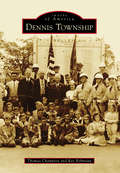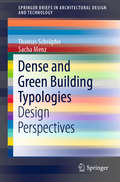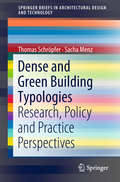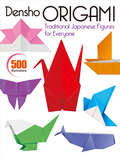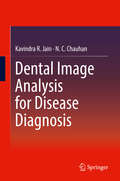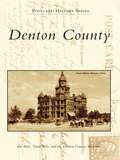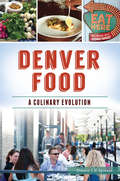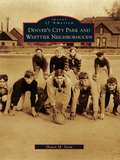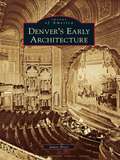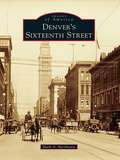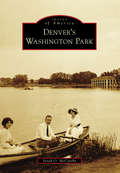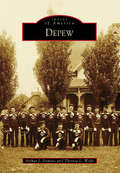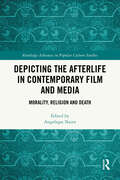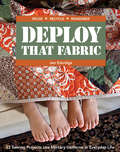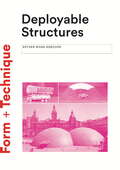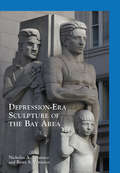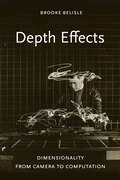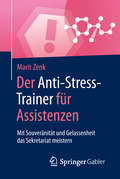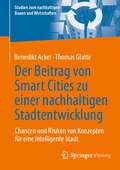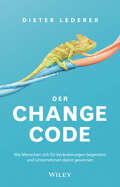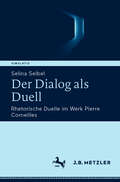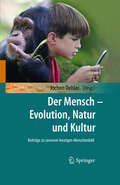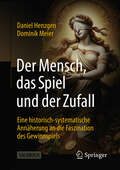- Table View
- List View
Dennis Township (Images of America)
by Thomas Champion Ray RebmannDennis Township is more than a swampy, desolate locale tourists drive through to reach the beach at the Jersey Shore. It is actually eight unique communities, stretching from the Garden State Parkway to the east to Delaware Bay and Cumberland County to the west. Dennis is farmland and forests of oak and pine. Meadows teem with wildlife, all just minutes away from busy beaches. Dennis Township is also about people, many of whom trace their roots back to before the American Revolution. It has a population of determined individualists, mixed with just enough "new blood" to sustain a vibrant community. Geography and people invigorate the township's eight hamlets, including Dennisville, Belleplain, and South Seaville, which were formerly independent towns but are now more regarded as signposts along the traveler's way. People have lived there for generations and will be living there still long after the tourists have moved on. This books tells more than one story, but all of the stories equally make Dennis Township the special place it long has been.
Dense and Green Building Typologies: Design Perspectives (SpringerBriefs in Architectural Design and Technology)
by Thomas Schröpfer Sacha MenzIn this book, leading architects and landscape architects provide their perspectives on the design of dense and green building types in high-density urban contexts that can support higher population densities, higher standards of environmental sustainability and enhanced liveability in future cities.
Dense and Green Building Typologies: Research, Policy and Practice Perspectives (SpringerBriefs in Architectural Design and Technology)
by Thomas Schröpfer Sacha MenzIn this book, academics, policy makers, developers, architects and landscape architects provide a systematic review of the environmental, social, economic and design benefits of dense and green building types in high-density urban contexts and discuss how these can support higher population densities, higher standards of environmental sustainability and enhanced live ability in future cities.
Densho Origami: Traditional Japanese Figures for Everyone
by Kodansha InternationalDensho origami is based on figures from Japanese folklore, handed down from generation to generation for over a hundred years. These densho origami figures are all quite simple to make, but beautiful and balanced, and are considered an expression of Japan's heart, soul, wisdom, and culture.Densho Origami introduces thirty-five of the most classic, beloved origami figures—the crane, the samurai helmet, the ninja star, the goldfish, etc. The instructions are extremely easy to follow and rely on over 500 3-D, computer-generated diagrams which guide the reader through each step.With its clean design, careful instructions, and highly-detailed diagrams, Densho Origami is the perfect first book for both children and adults who want to explore this charming, creative, and rewarding art. It's also an ideal way for adults to share origami with children, continuing the long tradition of passing on to the next generation, a love and appreciation for what's come before.
Dental Image Analysis for Disease Diagnosis
by Kavindra R. Jain N. C. ChauhanThis book provides an overview of computational approaches to medical image examination and analysis in oral radiology, utilizing dental radiograph to detect and diagnose dental caries in cases of decayed teeth. Coverage includes basic image processing techniques; approaches for Region of Interest extraction and analysis; and the role of computational clustering techniques for segmentation of teeth and dental caries. The book also presents a novel multiphase level set method for automatic segmentation of dental radiographs.
Denton County
by Tricia Bolz Jim Bolz Denton County MuseumsThe history of Denton County, founded in 1846, has been well preserved through postcards. These images, produced from vintage photographs and artist renditions, reflect a time when communication through postcards was quicker, easier, and less expensive than writing a letter. Inside this book, readers are treated to charming snapshots of local history depicting churches, the downtown public square, businesses, public schools, the two newly created universities, railroad depots, trolleys, the earliest automobiles, and some of Denton County's most familiar town views and tourist attractions.
Denver Food: A Culinary Evolution (American Palate)
by Simone Fm SpinnerAllured by the gold rush, waves of German, Japanese, Chinese and Italian immigrants brought their culinary proclivities to the American West. The early sophistication of saloons followed, and Denver's gastronomic landscape experienced a tremendous culinary evolution spanning sixteen decades. Dating back to the late 1800s, My Brother's Bar doesn't have a sign and doesn't need one, serving up history along with delicious hamburgers. Established in 1985, nonprofit Denver Urban Gardens operates more than 155 community gardens across the metropolitan region. Ahead of the curve, Chef Ryan Leinonen set the city on fire with the New Nordic trend more than a decade ago when he opened Trillium Restaurant. With these stories and more, author Simone FM Spinner follows the journey from dreams of gold to fine dining, and Denver has never been more delicious.
Denver's City Park and Whittier Neighborhoods (Images of America)
by Shawn M. SnowDenver was barely 10 years old in 1868 when visionary pioneers such as Alfred B. Case and Jacob W. Downing began amassing real estate holdings far from downtown, speculation that paid off when the newly arrived railroad led to a population explosion. With the opening of the Whittier School in 1883--the largest elementary school in the city--a domain for prairie dogs evolved into a middle-class haven of fine Victorian homes. Buffalo Bill Cody's sister even called the Whittier neighborhood home. The convenience and reliability of an expanding streetcar system brought the lifeblood of the city into the neighborhood. Whittier and its residents were also blessed with the establishment of a large, 320-acre park just to the east. This park, transformed from native prairie to irrigated forest, became one of the biggest attractions in Denver--City Park.
Denver's Early Architecture
by James BretzIn spite of its relentless reputation as a "cow town," Denver has grown from a dusty prairie burg into a thriving metropolis nestled against the foothills of the great Rocky Mountains. Gold brought the area's first settlers in the 1850s, and mining camps sprouted up along the confluence of Cherry Creek and the South Platte River. The first rudimentary structures of canvas, mud, and logs were soon replaced with sturdy buildings made of brick, stone, and wood, in what is now affectionately referred to as "Lodo" or the lower downtown district. City growth worked its way uptown and to the east from this neighborhood of houses, hotels, shops, and commercial buildings, eventually encompassing Capitol Hill. Many well-known people worked and lived in downtown Denver and Capitol Hill, including the infamous Margaret "Molly" Brown of Titanic fame, railroad man David Moffat, merchant prince Charles Boettcher, druggist-turned-entrepreneur Walter Scott Cheesman, and Denver's notorious lovers, Horace Tabor and his wife "Baby Doe."
Denver's Sixteenth Street
by Mark BarnhouseThe beloved thoroughfare at the heart of Denver, Sixteenth Street has always been the Mile-High City's "Main Street." Sixteenth Street got its jump start in 1879 when Leadville's Silver King and Colorado's richest man, Horace Austin Warner Tabor, came to town and built the city's first five-story skyscraper at the corner of Sixteenth and Larimer Streets. In coming years, Sixteenth Street became Denver's main retail center as shopkeepers and department store owners constructed ever-more impressive palaces, culminating in the Daniels and Fisher Tower--the city's tallest building for five decades and the symbol of the city. In the second half of the 20th century, Sixteenth Street saw major changes, including the creation of one of the most successful pedestrian malls in the country, an archetype of the power of great urban places and an inspiration to other cities, large and small.
Denver's Washington Park
by Sarah O. MccarthyIn the Rocky Mountain West, Denver is considered the big city. Yet its urban core consists of numerous neighborhoods developed in the late 19th century that act today as virtual small towns. South-central Denver's Washington Park is one of those "small towns," and its name refers both to a 166-acre historic park and to the surrounding blend of residential and commercial neighborhoods. Cited as a model for new urbanism, this area serves as an enduring example of the City Beautiful movement. Touted in the late 19th century for its "rapid transit," clean air, and pure water, the area once known as Broadway Terrace, Myrtle Hill, and the Miracle Mile of South Denver continues to serve as a recreational mecca for Denverites. Over a span of 100 years, it has transformed from prairie to potato fields to "posh."
Denys Arcand's Le Declin de l'empire americain and Les Invasions barbares
by Andrê LoiselleThe release of Denys Arcand's Le Déclin de l'empire américain (The Decline of the American Empire) in 1986 marked a major turning point in Quebec cinema. It was the first Québécois film that enjoyed huge critical and commercial success at home and abroad. Arcand's tragicomedy about eight intellectuals gathered around a dinner table relating sexy anecdotes became the top-grossing film of all time in Quebec and was the first Canadian feature to be nominated for an Oscar in the foreign-language category. Seventeen years later, Arcand won an Academy Award for the sequel, Les Invasions barbares (The Barbarian Invasions), where the amusing insouciance of the thirty-somethings talking dirty in Le Déclin is replaced by a sense of moral responsibility and serene resignation. In this engrossing study, André Loiselle presents the first in-depth analysis of both films within the context of Quebec culture. Through close readings and concise cultural analysis of two of the most important films in the history of Quebec cinema, Loiselle demonstrates the ways in which Arcand's work represents a snapshot of the evolution of the French Canadian film industry since 1980. The companion films trace the decline of Quebec's national dream and the Québécois' attempts to cling to their identity against the forces of barbaric globalization. The second title in the new Canadian Cinema series, Denys Arcand's "Le Déclin de l'empire américain" and "Les Invasions barbares" is essential reading for cinephiles, film critics, and anyone with an interest in cultural studies and Canadian and Quebec history.
Depew
by Arthur J. Domino Theresa L. WolfeWhen some of the richest men in America, including John Jacob Astor, realized in the 1890s that the New York Central, Lehigh Valley, Erie, and Delaware, Lackawanna & Western Railroads passed through a one-mile corridor, they began planning a community. In 1892, the renowned firm of Olmsted, Olmsted & Eliot designed a residential development surrounding manufacturing facilities. In 1894, it was incorporated as the village of Depew. The first tenant, the New York Central Locomotive Works, attracted a number of railroad-related industries, and Depew continued to grow until advances in technology and the Depression caused the New York Central to withdraw in 1931. Gradually, others such as Magnus Metal, National Battery, and Symington-Gould were phased out. Depew would never become a vast industrial complex as first planned, but today, the village is a mixture of residential and commercial development.
Depicting the Afterlife in Contemporary Film and Media: Morality, Religion and Death (Routledge Advances in Popular Culture Studies)
by Angelique NairnWhat lies beyond death? This book brings together a diverse collection of scholarly voices to explore how popular culture imagines—and reimagines—the afterlife. Drawing from film, television, video games, literature, advertising, and digital technologies, this book examines how narratives about Heaven and Hell, ghosts and gods, memory and immortality shape contemporary understandings of morality, death, and what may come after.From Pixar’s Coco to The Good Place, Ghostbusters, Upload, and Westworld, these chapters interrogate the enduring power of afterlife narratives to provide existential comfort, moral guidance, and cultural critique. Whether through the lens of theology, philosophy, or secular imagination, contributors consider how popular media blurs the sacred and the profane, challenging dogma, reframing ethics, and offering new possibilities for how we remember the dead and live among the living.Spanning topics such as queer love in the afterlife, Indigenous cosmologies, digital resurrection, and the theological implications of robots, Depicting the Afterlife in Contemporary Film and Media: Morality, Religion and Death is a timely exploration of how the afterlife continues to haunt and inspire modern culture.Essential reading for scholars of media studies, religious studies, cultural theory, and anyone fascinated by humanity’s oldest and most enduring question: what happens when we die?
Deploy That Fabric: 23 Sewing Projects Use Military Uniforms in Everyday Life
by Jen EskridgeTurn old uniforms into quilts, bags, and more: &“Because the projects are so nicely designed, they manage to be casual and classy at the same time.&” —Generation Q Magazine All members of the Armed Forces have to buy multiple uniforms, some of which become decommissioned. In this book, quilter and military spouse Jen Eskridge shows you how to recycle these uniforms and blend in some cheerful, contemporary fabrics to create useful, one-of-a-kind family treasures. Even if you don't have a service member in your life, you can make these cool projects using camouflage fabrics or uniforms purchased from surplus stores—and show your support in style!
Deployable Structures (Form + Technique)
by Esther Rivas Adrover Esther Rivas-AdroverDeployable structures can expand and contract due to their geometrical, material and mechanical properties – offering the potential to create truly transforming environments. This book looks at the cutting edge of the subject, examining the different types of deployable structures and numerous design approaches.Filled with photographs, models, drawings and diagrams, Deployable Structures is packed with inspirational ideas for architecture students and practitioners.
Deployable Structures (Small Architecture Ser.)
by Adrover EstherDeployable structures can expand and contract due to their geometrical, material and mechanical properties – offering the potential to create truly transforming environments. This book looks at the cutting edge of the subject, examining the different types of deployable structures and numerous design approaches.Filled with photographs, models, drawings and diagrams, Deployable Structures is packed with inspirational ideas for architecture students and practitioners.
Depression-Era Sculpture of the Bay Area
by Betty S. Veronico Nicholas A. VeronicoThe Great Depression was a terrible blow for the Bay Area’s thriving art community. A few private art projects kept a small number of sculptors working, but for the majority, prospects of finding new commissions were grim. By the mid-1930s, Pres. Franklin D. Roosevelt’s New Deal program had gathered steam, and assistance was provided to the nation’s art community. Salvation came from the Works Progress Administration (WPA), which employed thousands of artists to produce sculpture for public venues. The Bay Area art community subsequently benefitted from the need to fill the then-forthcoming Golden Gate International Exposition (GGIE) with sculpture of all shapes and sizes. As bad as the Depression was, its legacy more than 80 years on is one of beauty. The Bay Area is dotted with sculpture from this era, the majority of it on public display. Depression-Era Sculpture of the Bay Area is a visual tour of this artistic bounty.
Depth Effects: Dimensionality from Camera to Computation
by Brooke BelisleIn this bold rewriting of visual culture, Brooke Belisle uses dimensionality to rethink the history and theory of media aesthetics. With Depth Effects, she traces A.I.-enabled techniques of computational imaging back to spatial strategies of early photography, analyzing everyday smartphone apps by way of almost-forgotten media forms. Drawing on the work of Maurice Merleau-Ponty, Belisle explores depth both as a problem of visual representation (how can flat images depict a voluminous world?) and as a philosophical paradox (how do things cohere beyond the limits of our view?). She explains how today's depth effects continue colonialist ambitions toward totalizing ways of seeing. But she also shows how artists stage dimensionality to articulate what remains invisible and irreducible.
Der Anti-Stress-Trainer für Assistenzen
by Peter Buchenau Marit ZenkDieses Buch aus der Anti-Stress-Trainer Reihe ist die Erlösung für gestresste Assistenzen, die im Drehkreuz Sekretariat mit zig Bällen jonglieren. Spüren Sie den Druck, dem Sie unterliegen? Sei perfekt, sei stark, sei nett, sei schnell oder streng dich an - welcher Antreiber steckt in Ihnen? Zu Zeiten von 4.0 braucht selbst die modernste und versierteste Assistenz eine gute Strategie, um in der digital-verrückten Welt zu bestehen. Und zwar gesund! Lassen Sie sich Ihrer Illusionen „Jemals fertig zu werden“ und „Alles muss perfekt sein“ berauben. Neben dem erklärten Dilemma der Assistenz gibt es viele wertvolle Tipps zum Umgang mit Stress. Gepaart mit amüsanten Bildern, Sprüchen und Weisheiten bringt die Autorin Sie sicher zum Schmunzeln! Lassen Sie sich von Marit Zenk mit auf die Reise in Ihre Welt nehmen.
Der Beitrag von Smart Cities zu einer nachhaltigen Stadtentwicklung: Chancen und Risiken von Konzepten für eine intelligente Stadt (Studien zum nachhaltigen Bauen und Wirtschaften)
by Thomas Glatte Benedikt AckerDieses Fachbuch vermittelt einen umfassenden Überblick über den Beitrag, welchen eine Smart City zu einer nachhaltigen Stadtentwicklung leisten kann. Unter Bezugnahme aktuell präsenter Megatrends erfolgt eine systematische Einordnung der Rolle der Immobilienwirtschaft im umfassenden Konstrukt einer intelligenten Stadt. Mittels Analysen vielversprechender Konzepte im Bereich der Smart City wird dabei der zusätzliche Mehrwert herausgearbeitet, welcher im Kontext der Nachhaltigkeit bei der Modernisierung und Revitalisierung von Gebäuden und Quartieren entstehen kann.
Der Change-Code: Wie Menschen sich für Veränderungen begeistern und Unternehmen damit gewinnen
by Dieter LedererFakten führen zum Denken, Emotionen führen zum Handeln. Die Quote ist seit Jahren unverändert: Drei Viertel aller Change-Programme in Unternehmen gehen schief. Sie liefern nicht das, was sie sollen. Mit der Folge, dass Geld, Motivation und Wettbewerbsfähigkeit schwinden. Klar ist: So kann es nicht weitergehen. Angesichts der immensen Herausforderungen und Umbrüche, vor denen wir allenthalben stehen, ist es höchste Zeit, dass der Pfusch beim Change aufhört. Wie das funktioniert, verrät dieses Buch - mit einer überraschend einfachen Lösung: Es lädt dazu ein, konsequent auf das zu fokussieren, was Menschen brauchen, um sich für Wandel zu begeistern. Denn nur dann werden sie sich bewegen. Nur dann werden sie sich vertrauensvoll auf eine neue unternehmerische Richtung einlassen und sie kraftvoll umsetzen. Das Kompendium menschenorientierter Veränderung und Transformation.
Der Dialog als Duell: Rhetorische Duelle im Werk Pierre Corneilles (Simulatio. Theatertechniken in Literatur, Medien und Wissenschaft)
by Selina SeibelDie vorliegende Studie untersucht erstmals die Transposition des Duells in den dramatischen Dialog bei Pierre Corneille. Sie verfolgt zwei Ziele: Zum einen werden die kulturhistorischen Voraussetzungen und mentalitätsgeschichtlichen Entwicklungen in den Blick genommen, die in der Gesellschaft des siècle classique zur Rhetorisierung des Duells führen und auf Corneilles Theaterproduktion einwirken. Zum anderen wird das rhetorische Duell als konfrontative Dialogform und strukturgebendes Element im Theater Corneilles gattungsübergreifend entwickelt und analysiert. Es wird weiterhin gezeigt, dass das rhetorische Duell zum Bestandteil von Corneilles Theaterapologie wird und in die dramenpoetologischen und -theoretischen Diskussionen der Zeit einzubinden ist.
Der Mensch - Evolution, Natur und Kultur
by Jochen OehlerGut 150 Jahren sind vergangen, seit Darwin sein Werk "Die Entstehung der Arten" geschrieben hat. Das Evolutionsparadigma hat inzwischen als erfolgreicher Forschungsansatz dazu beigetragen, u. a. psychologische, soziale, ethische, ästhetische oder auch politische Fragen zu klären. Namhafte Natur- und Geisteswissenschaftler zeigen in dem Band die Möglichkeiten evolutionärer Erklärungen und Vorhersagen auf. Durch die interdisziplinäre Herangehensweise ergibt sich ein ganzheitliches Bild der Herkunft und der Daseinsweise des Menschen aus heutiger Sicht.
Der Mensch, das Spiel und der Zufall: Eine historisch-systematische Annäherung an die Faszination des Gewinnspiels
by Dominik Meier Daniel HenzgenDas vorliegende Buch Der Mensch, das Spiel und der Zufall bietet eine historisch-systematische Analyse des Gewinnspiels und seines ewigen Reizes für uns Menschen. Aufbauend auf Erkenntnissen der Geschichtswissenschaft, Philosophie, Ökonomie, Statistik und Psychologie, ergründet es die Faszination des spielerischen Ringens mit dem Zufall – und warum Gewinnspiele seit jeher ein Kampfplatz von Ideologien, Moralvorstellungen, Lebenskonzeptionen und Machtinteressen sind. Der Band setzt einen Denkanstoß für jeden, der sich privat oder beruflich mit Gewinnspielen beschäftigt oder einfach von diesem weiten Feld fasziniert ist. Die Abhandlung bietet strategisches Orientierungswissen zur weiteren Meinungsbildung und versteht sich als Grundlagenwerk, das ein breites Publikum aus Wissenschaft, Wirtschaft, Gesellschaft und Politik zum Nachdenken anregen soll.
